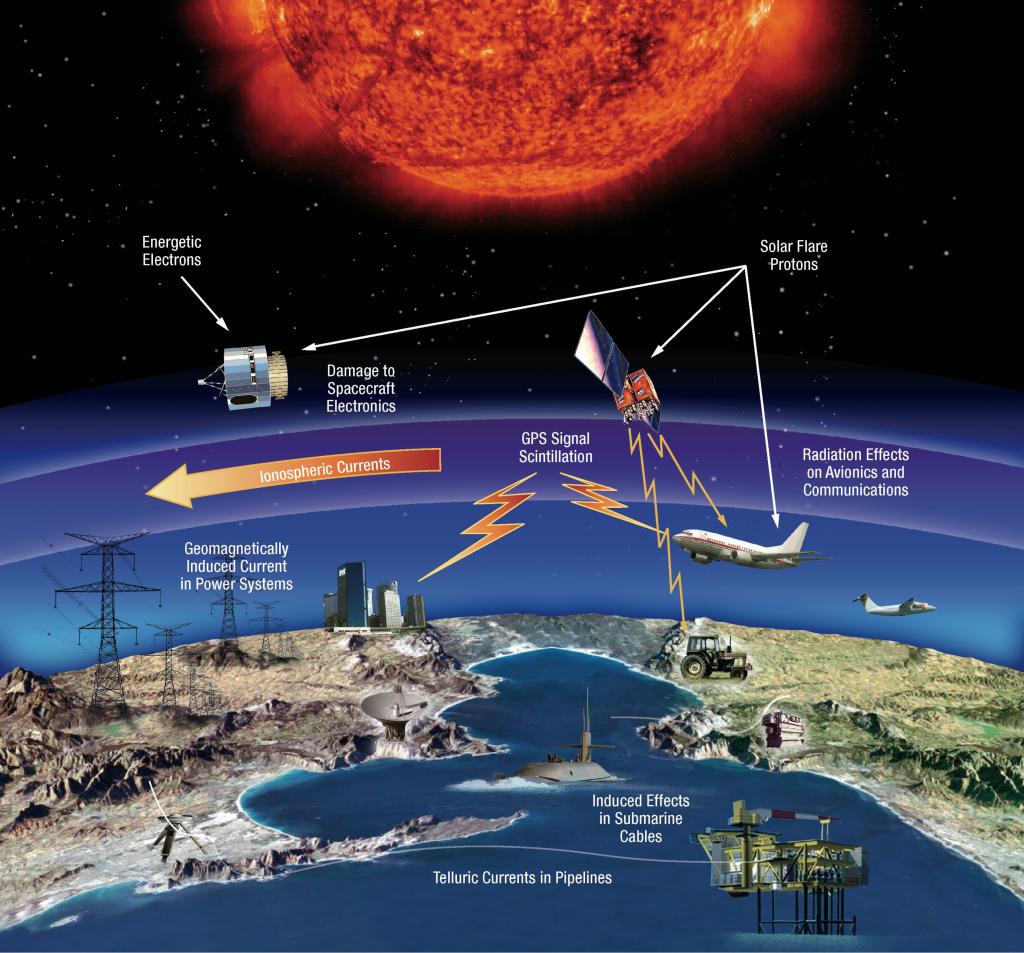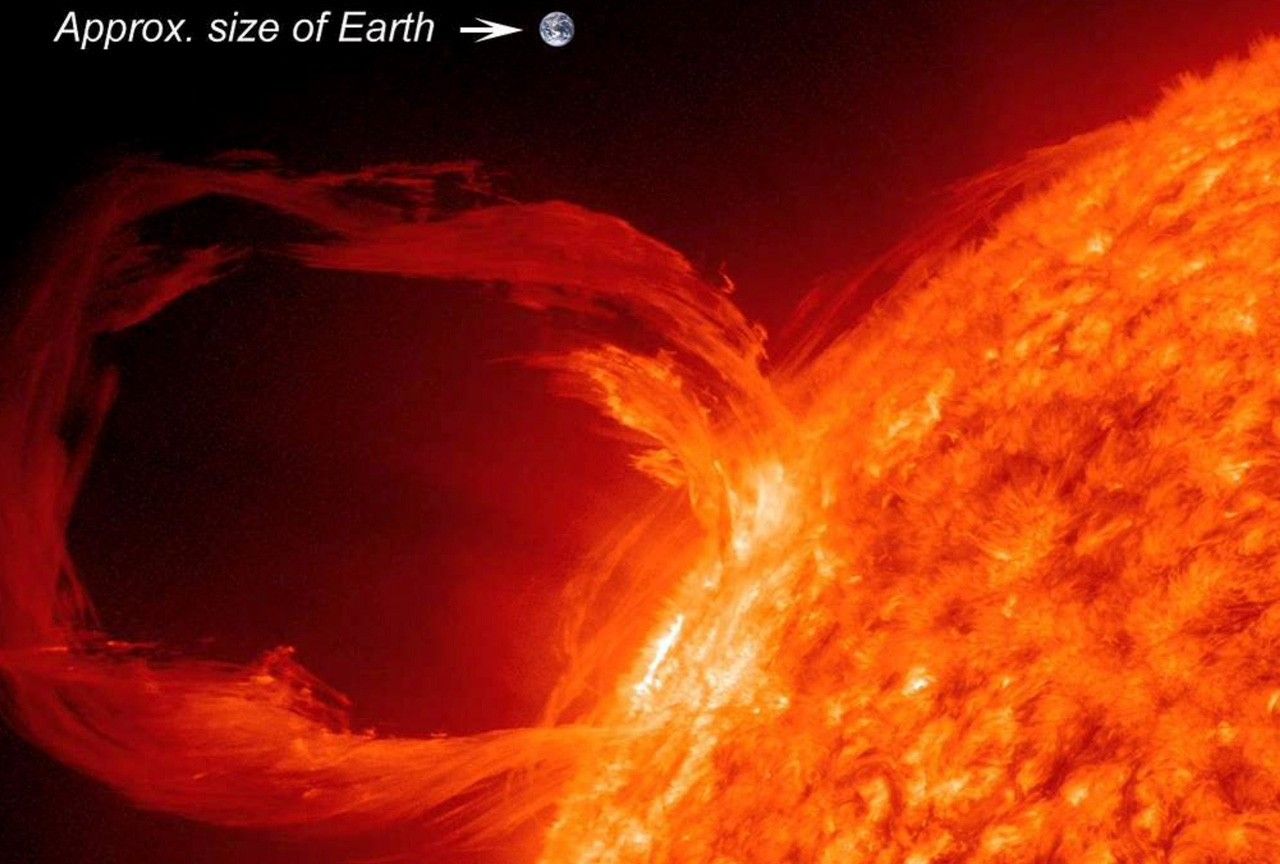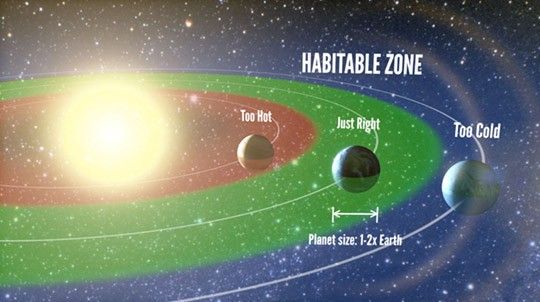What is Heliophysics?
Heliophysics is the study of our star, the Sun [helio], and how its behavior [physics] affects Earth, the solar system, and the very nature of space.
The Science Mission Directorate Heliophysics Division studies the nature of the Sun, and how it influences the very nature of space – and, in turn, the atmospheres of planets and the technology that exists there. Space is not, as is often believed, completely empty; instead, we live in the extended atmosphere of an active star. Our Sun sends out a steady outpouring of particles and energy – the solar wind – as well as a constantly writhing magnetic system. This extensive, dynamic solar atmosphere surrounds the Sun, Earth, the planets, and extends far out into the solar system.

Why Teach Heliophysics?
Everyone has a connection to the Sun!
The Sun can provide a fun and exciting laboratory for exploring magnetism, gravity, light, energy, and much more! Learning about the Sun and its influence on the solar system can help scientists understand how the universe began, how stars and planets are formed, and how life can exist on Earth. Studying this system not only helps us understand fundamental information about how the universe works, but also helps protect our technology and astronauts in space. NASA seeks knowledge of near-Earth space, because – when extreme – space weather can interfere with our communications, satellites and power grids.
“Heliophysics education activation” is a need because [1] heliophysics is a relatively new discipline of science, so therefore [2] people are unfamiliar with the term and [3] many educators may feel intimidated by the term. The term is also not mentioned in the Next Generation Science Standards (NGSS) and the heliosphere is not included in models of Earth’s systems.

Heliophysics Topics
Heliophysics topics are naturally interdisciplinary and offer an engaging way to explore Earth science concepts, as well as demonstrate the fundamentals of physical and life sciences.
From the core of the Sun, where nuclear fusion reactions create its energy, to auroral displays in Earth’s atmosphere, heliophysics topics span beyond solar science. Popular heliophysics topics include: aurora, coronal mass ejection, solar flare, geomagnetic storm, magnetic reconnection, solar eclipse, solar wind, space weather, and sunspot.

Heliophysics Missions
The NASA Heliophysics Systems Observatory works with other NASA systems observatories to give NASA a complete picture of the Sun-Earth System.
By studying the Sun and other objects in the solar system, scientists can learn more about other stars and planetary systems. In turn, learning about other stars can teach us about the origin of our solar system and the origin of life on Earth. NASA’s heliophysics mission fleet spans the entire heliosphere. From the Voyager Mission, which crossed the heliosphere boundary, and is the only human-made object to leave the heliosphere; to Parker Solar Probe, which will fly into the atmosphere of the Sun, and will be the closest human-made object to ever "touch the Sun."

Heliophysics and the NGSS
The Next Generation Science Standards (NGSS) were created by the National Research Council's (NRC) framework for K-12 Science Education and drive the science curricula in forty-four states.
Using the three main questions that heliophysicists investigate as the foundation the Framework for Heliophysics Education cross-references heliophysics topics with NGSS disciplinary core ideas to allow classroom teachers to easily infuse heliophysics concepts into existing Earth, physical, and life science curricula. The NGSS also serves as a research-based guide for what students can learn at each level which can be used by informal educators, communicators, and outreach specialists to plan age-appropriate activities for events.
Start exploring the Heliophysics Big Ideas below to find age-appropriate activities and resources for your learners! Or go directly to searching our Resource Database and filter by NGSS performance expectation.

Heliophysics Big Ideas

The Sun is really big and influences all objects in the solar system.
Heliophysics Big Idea 1.1
Driving Question: What are the impacts of the changing Sun on humanity?
Relevant Topics: corona, lunar eclipse, lunar phases, Newton's Law of Gravity, seasons, solar eclipse, solar system, transits

The Sun is active and can impact technology on Earth via space weather.
Heliophysics Big Idea 1.2
Driving Question: What are the impacts of the changing Sun on humanity?
Relevant Topics: atmosphere, aurora, geomagnetic storm, ionization, magnetic fields, magnetic reconnection, magnetosphere, magnetotail, plasma, radio blackout, solar cycle, solar flare, solar wind, space weather, sunspots, Van Allen belts

The Sun's energy drives Earth's climate, but the climate is in a delicate balance and is changing due to human activity.
Heliophysics Big Idea 1.3
Driving Question: What are the impacts of the changing Sun on humanity?
Relevant Topics: atmosphere, climate change, energy, greenhouse effect, radiation

Life on Earth has evolved with complex diversity because of our location near the Sun. It is just right!
Heliophysics Big Idea 2.1
Driving Question: How do Earth, the solar system, and the heliosphere respond to changes on the Sun?
Relevant Topics: biosphere, energy, habitable zone, light, magnetosphere, photosynthesis, radiation

The Sun defines the space around it, which is different from interstellar space.
Heliophysics Big Idea 2.2
Driving Question: How do Earth, the solar system, and the heliosphere respond to changes on the Sun?
Relevant Topics: heliosphere, interstellar space, magnetic fields, plasma, solar wind, space weather

The Sun is the primary light source in the solar system.
Heliophysics Big Idea 2.3
Driving Question: How do Earth, the solar system, and the heliosphere respond to changes on the Sun?
Relevant Topics: electromagnetic spectrum, energy, light, photosynthesis, radiation, spectroscopy

The Sun is made of churning plasma, causing the surface to be covered with complex, tangled magnetic fields.
Heliophysics Big Idea 3.1
Driving Question: What causes the Sun to vary?
Relevant Topics: coronal mass ejection, electromagnetism, energy, ionization, magnetic fields, magnetic reconnection, plasma, solar cycle, solar flare, solar wind, space weather, sunspots

Energy from the Sun is created in the core and travels outward through the Sun and into the heliosphere.
Heliophysics Big Idea 3.2
Driving Question: What causes the Sun to vary?
Relevant Topics: convection, corona, energy, heliosphere, light, nuclear fusion, plasma, radiation, solar wind, space weather

Our Sun, like all stars, has a life cycle.
Heliophysics Big Idea 3.3
Driving Question: What causes the Sun to vary?
Relevant Topics: light, nuclear fusion, solar cycle, spectroscopy, stellar evolution, sunspots
Heliophysics Resource Database
Explore the Heliophysics Big Ideas above or go directly to our database to search for resources by level, NGSS performance expectation, topic, and mission.
Resource Database




























